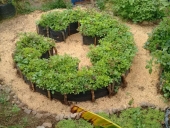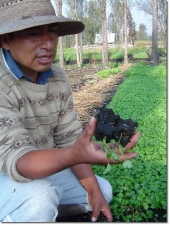More images of chinampas: Lancha atada en la entrada de una chinampa (TRANSLATION: boat tied up in the entrance of a chinampa) by Emmanuel Eslava from WikiMedia.org; Tenochtitlan from Ancient.eu; Tenochtitlan illustration from ThingLink.com
"
Mexico-Tenochtitlan (today -with its endangered chinampa system- it's known as Mexico City): Founded on June 20, 1325, it became the capital of the expanding Aztec Empire in the 15th century, until it was captured by the Spanish in 1521. At its peak it was the largest city in the Pre-Columbian Americas.
The city was connected to the mainland by causeways leading to the north, south, and west. The causeways were interrupted by bridges that allowed canoes and other water traffic to pass freely. The bridges could be pulled away, if necessary, to defend the city. The city was interlaced with a series of canals, so that all sections of the city could be visited either on foot or via canoe.
Lake Texcoco was the largest of five interconnected lakes. Since it formed in an endorheic basin, Lake Texcoco was brackish. During the reign of Moctezuma I, the "levee of Nezahualcoyotl" was constructed, reputedly designed by Nezahualcoyotl. Estimated to be 12 to 16 km (7.5 to 9.9 mi) in length, the levee was completed circa 1453. The levee kept fresh spring-fed water in the waters around Tenochtitlan and kept the brackish waters beyond the dike, to the east.
Two double aqueducts, each more than 4 km (2.5 mi) long and made of terracotta, provided the city with fresh water from the springs at Chapultepec. This was intended mainly for cleaning and washing. For drinking, water from mountain springs was preferred. Most of the population liked to bathe twice a day; Moctezuma was said to take four baths a day. According to the context of Aztec culture in literature, the soap that they most likely used was the root of a plant called copalxocotl (Saponaria americana), and to clean their clothes they used the root of metl (Agave americana). Also, the upper classes and pregnant women washed themselves in a temazcalli, similar to a sauna bath, which is still used in the south of Mexico. This was also popular in other Mesoamerican cultures.
When we saw so many cities and villages built in the water and other great towns on dry land we were amazed and said that
it was like the enchantments (...) on account of the great towers and cues and buildings rising from the water, and all built of masonry. And some of our soldiers even asked whether the things that we saw were not a dream? (...) I do not know how to describe it, seeing things as we did that had never been heard of or seen before, not even dreamed about. — Bernal Díaz del Castillo, The Conquest of New Spain
Surrounding the raised causeways were artificial floating gardens with canal waterways and gardens of plants, shrubs, and trees. The calpullis were divided by channels used for transportation, with wood bridges that were removed at night.
Tenochtitlan was the capital of the Mexican civilization of the Mexica people founded in 1325. The state religion of the Mexica civilization awaited the fulfillment of an ancient prophecy: the wandering tribes would find the destined site for a great city whose location would be signaled by an eagle eating a snake perched atop a cactus.
The Mexica saw this vision on what was then a small swampy island in Lake Texcoco, a vision that is now immortalized in Mexico's coat of arms and on the Mexican flag.
Not deterred by the unfavourable terrain, they set about building their city, using the chinampa system (misnamed as "floating gardens") for agriculture and to dry and expand the island.
With an estimated population between 200,000 and 300,000, many scholars believe Tenochtitlan to have been among the largest cities in the world at that time. Compared to Europe, only Paris, Venice and Constantinople might have rivaled it. It was five times the size of the London of Henry VIII. In a letter to the Spanish king, Cortés wrote that Tenochtitlan was as large as Seville or Córdoba. Cortes' men were in awe at the sight of the splendid city and many wondered if they were dreaming."
https://en.wikipedia.org/wiki/Tenochtitlan
If you have any images you'd like to share, please add to the thread. Thanks


 3
3




![Filename: chinampa_anthrome.files.wordpress.com.gif
Description: chinampa by anthrome.files.wordpress.com [Thumbnail for chinampa_anthrome.files.wordpress.com.gif]](/t/63991/a/48739/chinampa_anthrome.files.wordpress.com.gif)
 2
2





 2
2





![Filename: chinampa_projetsdepaysage.fr.jpg
Description: chinampa from projetsdepaysage.fr [Thumbnail for chinampa_projetsdepaysage.fr.jpg]](/t/63991/a/48836/chinampa_projetsdepaysage.fr.jpg)
 3
3





![Filename: chinampa_tool_PensamientoAutodidacta.blogspot.com.jpg
Description: chinampa tool PensamientoAutodidacta.blogspot.com [Thumbnail for chinampa_tool_PensamientoAutodidacta.blogspot.com.jpg]](/t/63991/a/48901/chinampa_tool_PensamientoAutodidacta.blogspot.com.jpg)
 2
2





![Filename: Chinampas_by_Karl_Weule-_Leitfaden_der_Voelkerkunde-_Leipzig_1912_WikiMedia.org.jpg
Description: Chinampas by Karl Weule, Leitfaden der Voelkerkunde, Leipzig 1912 WikiMedia.org [Thumbnail for Chinampas_by_Karl_Weule-_Leitfaden_der_Voelkerkunde-_Leipzig_1912_WikiMedia.org.jpg]](/t/63991/a/48955/thumb-Chinampas_by_Karl_Weule-_Leitfaden_der_Voelkerkunde-_Leipzig_1912_WikiMedia.org.jpg)
![Filename: Chinampas_capillary_diagram_MidwestPermaculture.com.jpg
Description: Chinampas capillary diagram from MidwestPermaculture.com [Thumbnail for Chinampas_capillary_diagram_MidwestPermaculture.com.jpg]](/t/63991/a/48956/Chinampas_capillary_diagram_MidwestPermaculture.com.jpg)
 2
2





![Filename: Chinampas_diagram_MidwestPermaculture.com.jpg
Description: Chinampas diagram from MidwestPermaculture.com [Thumbnail for Chinampas_diagram_MidwestPermaculture.com.jpg]](/t/63991/a/48979/Chinampas_diagram_MidwestPermaculture.com.jpg)
 3
3










![Filename: Chinampas_trellises_diagram_MidwestPermaculture.com.jpg
Description: Chinampas trellises diagram from MidwestPermaculture.com [Thumbnail for Chinampas_trellises_diagram_MidwestPermaculture.com.jpg]](/t/63991/a/49011/Chinampas_trellises_diagram_MidwestPermaculture.com.jpg)





 1
1














 1
1






















 1
1













